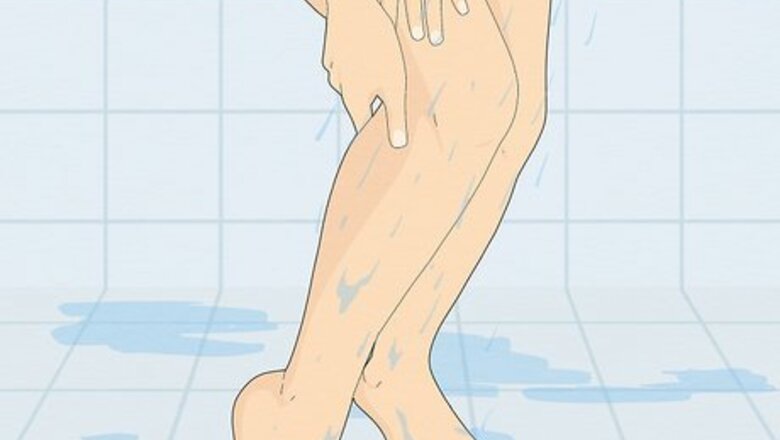
views
Changing Your Bathing Routine
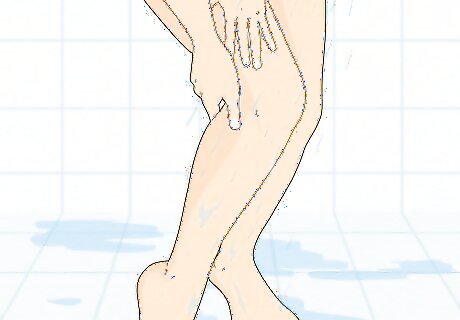
Adjust how often you shower. When you shower, you wash away a lot of the natural oils in your skin. Those natural oils not only keep your skin moist, they also protect your skin from damage which can cause even more dryness. If you shower too often, you might be removing more of these natural oils than your skin can replace, leading to dry legs. Try showering once a day or every other day. If you have to shower in between, use cooler water and only soap the most affected areas (like your armpits and groin area). Showering for too long or too often can also cause problems. Bathe for no more than 10 to 15 minutes at a time, no more than once per day.

Shower with warm water. The other part of your bathing routine that removes a lot of your natural, protective oils the temperature you set your shower or bathwater to. Really hot water clears your skin of those natural oils and dries you out. You’ll want to switch to water which is only just barely warm, if you want to keep from irritating your legs. Most people don’t have a water thermometer they can use with their bath or shower, so how do you know how hot is too hot? Use the general rule that if you wouldn’t put a baby in it, you shouldn’t put yourself in it either. Test the temperature against the most sensitive parts of your skin (like the insides of your wrist) and otherwise keep the water as cold as you can stand it.
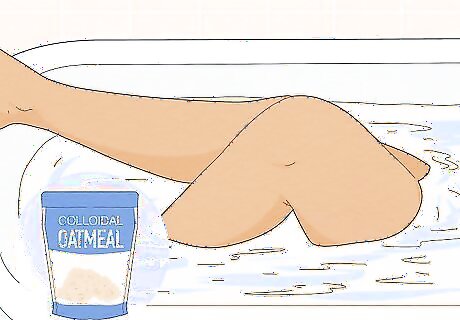
Take a warm oatmeal bath. Oatmeal baths can soothe your skin and help your relieve any itching. Mix 1 cup (85 g) of colloidal or ground oatmeal into a warm bath. Then, soak for about 20 minutes. Rinse off with cool water, then towel yourself dry. You can find colloidal oatmeal in the bath department of your local store or online. If you want to make your own colloidal oatmeal, put regular rolled oats into a blender and grind them into a finer consistency.
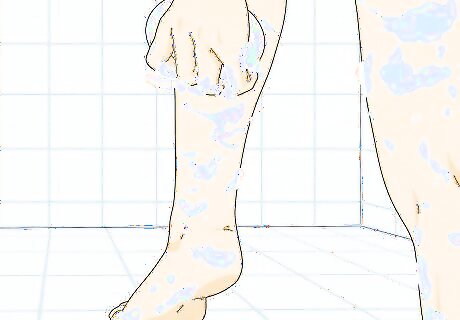
Avoid harsh soaps. Soaps which are designed to deal with oil skin or which are badly pH balanced can aggravate your sensitive skin. Look for soaps that are designed for “sensitive skin” or that include moisturizers. One study found Dove soaps, and specifically Dove White and Dove Baby to be the most pH balanced for sensitive skin.
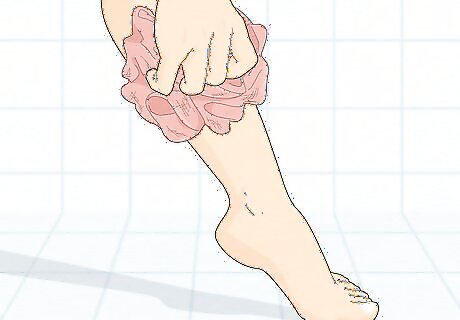
Be gentle with your skin. When you go through your hygiene routine, it’s a good idea to be gentle with your skin. Your skin is very sensitive and the skin on your legs is specifically very thin and prone to problems. Treat it kindly to help your skin heal and prevent problems from coming back. Exfoliate your skin occasionally. Exfoliating is good for your skin but you need to do it in a gentle way and not exfoliate too often. A baking soda paste or washcloth should be more than enough to remove dead skin cells, while items like loofahs and pumice stones can actually make the problem worse. Use a fresh razor and shave gently, if you shave your legs. Dull razors can irritate your skin and make the problem worse or even cause it to begin with. Make sure you shave in the direction of the hair growth, which is up to down.

Air dry or pat dry. You’ll also want to be gentle when you dry your skin after bathing. Rubbing a towel vigorously on your skin can cause it to become overly dry by irritating the skin and removing too much of the natural moisture. Let yourself air dry if you can and otherwise only lightly pat your skin dry with a soft, clean towel.
Moisturizing
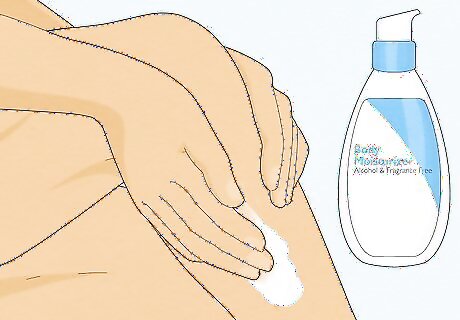
Apply moisturizer right out of the shower. As soon as you get out of the shower or bath, apply at least a light layer of moisturizer. This will help replace the natural oils that may have been removed by bathing and will also help lock in the moisture absorbed while you were in the water. If you do not have time to shower but you want to moisturize your legs, wrap them in a warm, wet cloth for 10 to 20 minutes. This will moisten your skin and open up your pores, so that the moisturizer can be properly absorbed.
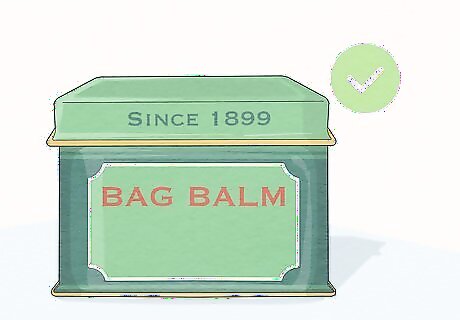
Try to use lanolin-based creams. Lanolin is one of the few products which is known to produce lasting effects on the skin. It is a natural product made from a wax naturally produced by wool-producing animals like sheep, which is specifically designed to protect skin. Liberally coat your legs in lanolin cream, such as Bag Balm, every day for a week. Once this week has passed, you can move to coating with only a normal layer once every 3-4 days. You can also coat your legs at night and then wear some old pajamas over the top, letting the product sink in while you sleep.
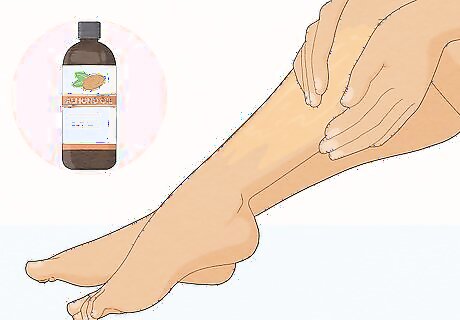
Use oils. Baby oil, coconut oil, sesame seed oil, and almond oil all make great moisturizers. Any one of these can be really helpful for getting your skin back to normality. It's not always the best long-term solution, however. If you shave your legs, the oil can cause irritation and block the hair follicle, causing ingrown hairs. For this reason, you might not want to rely on oil all of the time, though applying the oil in the direction of your hair growth can help. However, for just helping your skin heal while you work on changes to your routine or for protecting your skin during the coldest days of winter, oil is great.
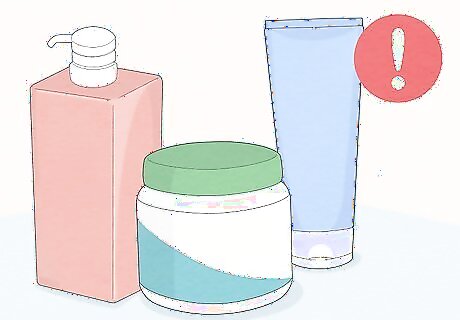
Avoid most other moisturizers. Many other moisturizers do very, very little for your skin. Many are just a layer of goo that basically just sits on top of your skin. Look for the known ingredients which help skin, humectants and emollients, and pass on all those other creams because they're just a waste of money. You want products that contain ingredients like lactic acid, Propylene glycol, and urea. One ingredient you'll really want to avoid is fragrance. Lots of fragrance chemicals are irritating to skin, so you should avoid them.
The Whole-Body Approach
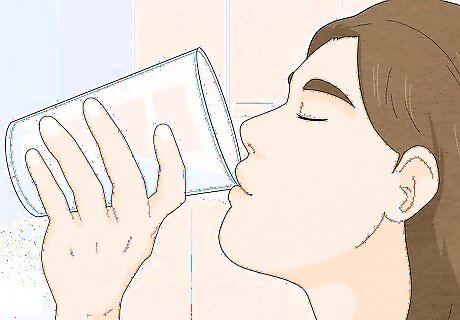
Drink more water. When you don’t drink enough water, you skin will be one of your first organs to suffer. Dehydration will quickly cause dry skin, as well as a number of other health problems. Drink plenty of water every day so that you can protect your skin and the rest of your body too. How much is enough is different for everyone. The recommendation of eight glasses a day is just a ballpark number.

Protect your skin from the cold. When air gets cold, moisture is naturally precipitated out of the air, leaving the air much drier than normal. When the air is dry, it leaches moisture from your skin (to help reach a sort of balance). This is why your skin is always much dryer in winter. Protecting your skin from the cold, by wearing protective clothing and covering your skin in moisturizer, can prevent dry skin. To protect your legs, try wearing stockings or another light layer on underneath your pants during the winter. This will help protect your skin, since denim is especially poor at keeping your skin warm and protected.

Maintain the moisture level in your home. Dry, hot air will leech moisture from your skin so increased humidity in the home will help your skin retain moisture. Keeping a small humidifier in your bedroom at night will make a big difference, and if you can keep one in the other major rooms of your house, that can also help. Just be sure not to over humidify your home. This can cause mold problems, which will also have negative health effects.

Avoid too much sun exposure. Getting 10-30 minutes of sun a day can help your body produce vitamin D, but too much sun is harmful for your skin. Aside from just putting you at greater risk of skin cancer, it can also irritate your skin and cause dry skin. Wear light but covering clothes when you go out in the sun, especially in the midday, such as linen pants. If you can’t or don’t want to cover your skin with fabric, you should at least use sunscreen. Use a broad spectrum (UVA/UVB) sunscreen and be sure to apply it as directed. SPF 15 should be plenty to protect your skin.

Adjust your diet to get vital skin nutrients. You might know that you need vitamin C to ward off sickness or that your muscles need protein, but do you know what your skin needs to stay healthy? You skin also needs specific nutrients in order to be at its best so you’ll want to make sure your diet has an adequate amount of three major nutrients: vitamin E, vitamin A, and omega-3 fatty acids. Good sources of these nutrients include sardines, anchovies, salmon, almonds, olive oil, carrots and kale. You can also take supplements, although your body might not always absorb these as well as the nutrients found naturally in food.
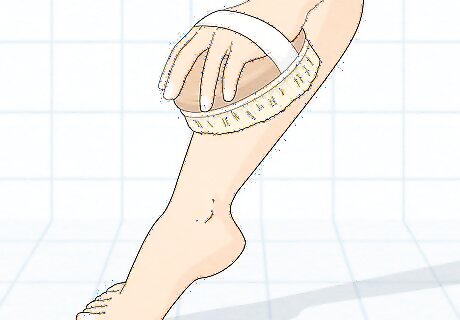
Try dry skin brushing before you bathe. Invest in a pure bristle brush, but not one that is too hard or you'll hurt your skin. Proceed to slowly brush your legs, front and back, taking care to not overdo it. Then shower off and use a good quality coconut, almond or grapeseed oil after. Lotions can make it worse, so avoid these. Your legs will stop being powdery. If you have a medical problem, talk to a doctor before dry skin brushing.
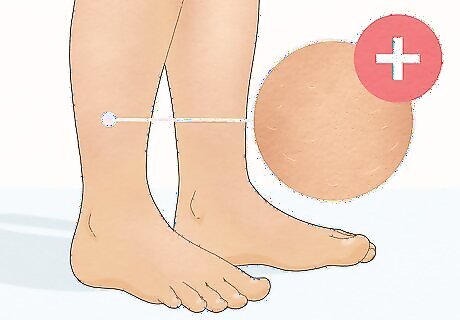
Talk to a doctor. If you’re trying all of these techniques and you find that you still suffer from really dry skin, it might be a good idea to talk to a doctor. You will want to rule out medical causes. A symptom of some diseases can be dry skin and some medications may cause dry skin as a side effect. It is important to visit with your doctor to ensure that your dry skin isn't a result of a medical or pharmacological issue.




















Comments
0 comment